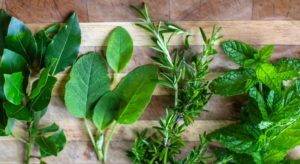Grow Fresh Flavor All Year Long
 A few years ago I decided to start an herb garden, but it’s not your traditional herb garden. My “garden” is comprised of a plant stand, which I found at a local gardening store, and terracotta pots painted to match. The herbs I selected include: sage, rosemary, thyme, basil and oregano. I also have a habanero pepper in a pot next to the stand.
A few years ago I decided to start an herb garden, but it’s not your traditional herb garden. My “garden” is comprised of a plant stand, which I found at a local gardening store, and terracotta pots painted to match. The herbs I selected include: sage, rosemary, thyme, basil and oregano. I also have a habanero pepper in a pot next to the stand.
Although potted herbs are growing in my breezeway now, I can move them indoors when it gets cold. I was motivated to plant this herb garden in anticipation of our family’s canning weekend, which has become an annual event spread over two weeks. It begins when my mother-in-law and I head to the Mennonite Auction Houses. We’ll bid against grocery store buyers and others to get the best price that we can for bulk canner tomatoes, which we’ll use to build up the liquid volume of our sauce.
 We’ll come home with a load of tomatoes and other fresh produce including raspberries for jam, gourds for fall décor, pickles for canning, onions and other homegrown veggies.
We’ll come home with a load of tomatoes and other fresh produce including raspberries for jam, gourds for fall décor, pickles for canning, onions and other homegrown veggies.
After returning home from the auction house, we’ll set the tomatoes outside on picnic tables to continue ripening so they’re ready for the canning weekend. The remaining ingredients for our sauce will be picked fresh from our own 30 Roma Tomato plants and our two herb gardens.
The actual recipe for this sauce has been handed down from one generation to the next, so I’m sworn to secrecy! But I will list the ingredients and provide a few directions, so you can try your hand at brewing your own blend of spaghetti sauce.
Cunningham Homemade Spaghetti Sauce
Ingredients
Ingredients:
- Large Tomatoes
- Roma Tomatoes
- Fresh Onion
- Fresh Habanero Pepper
- Olive Oil
- Fresh Garlic
- Sage
- Rosemary
- Thyme
- Basil
- Oregano
Instructions
Directions:
- Large tomatoes, Roma tomatoes, onion and garlic are rough cut into pieces and added to a large pot in raw form. My mother-in-law uses a large stock pot (her specific pan is probably the secret to her success), but I’ve found that for me Dutch oven pans work better. It places more surface area of the mixture closer to the heat source allowing it to reduce faster and burn less.
- The herbs are blended in a food processor and also added to the pan along with some olive oil. Any extra space in the pan is filled with Roma tomatoes. These will add thickness to your sauce. Place the pan on low heat to cook and reduce as long as needed. A large stock pot may take around five hours, smaller dutch oven pans take a little less than 3 hours. This is the point where during our canning weekend we would switch to making salsa, jam and pickles while the other pans cooked. There's nothing like multi-tasking in the kitchen!
- When the sauce has reduced to minimal liquid stage, remove from heat and run the mixture through a food mill to remove skins and chunks. Fill quart or pint jars to the edge of the top lip, secure lids and place in the oven at 250° for 3 hours. You can also use a pressure canner, but the oven method allows us to can larger amounts of jars at one time (since we can spread it over four houses worth of ovens).
- We typically can 40 to 50 jars for each household. The sauce great with pasta for the traditional spaghetti, but the spiciness makes it great to use in chili's and lasagna or any recipe that’s tomato-based and could stand a bit of heat.
Notes
a Cunningham Family Tradition